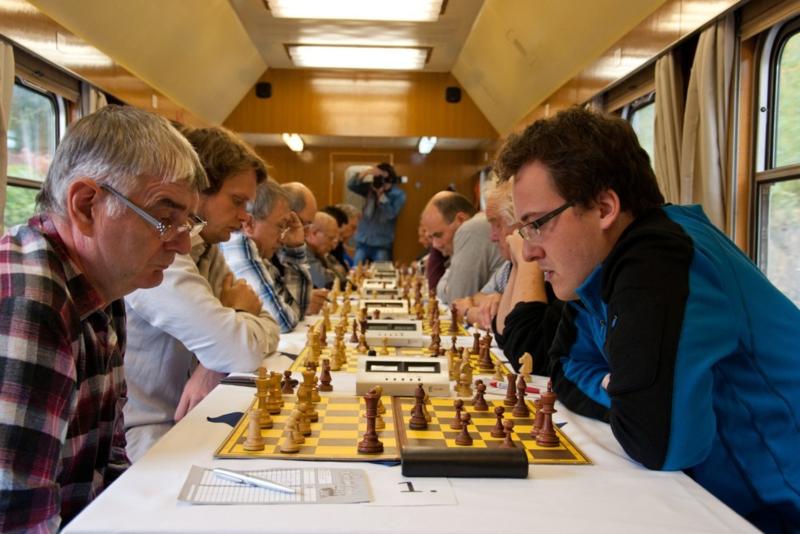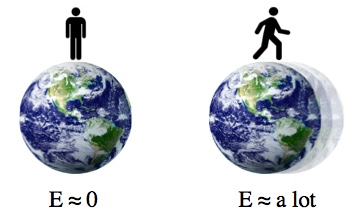The original question was: … in a scenario with two cars driving towards each other, the system could be measured externally to have an energy equal to the sum of the kinetic energy in the two cars. However, if you are in one of those cars, you would see the other car moving towards you at twice the speed you are traveling, and that you are not moving at all. If that is the case, then calculating the energy in the system means instead of summing the energy of two cars moving, you have one car moving at twice the speed, which means four times the energy of one car and twice the energy of the original system. How is it that from one perspective, a system can have twice as much energy?

Kinetic energy is given by E=0.5mv2. With a little math you’ll find that different perspectives of the same event result in different amounts of total energy.
Physicist: When you hear about the conservation of energy it’s natural to think of it as being something like the “conservation of chairs”: there is a total and that total never changes. But while differently moving observers will agree on chair count, they’ll disagree on how fast those chairs (and everything else) are moving. Velocity is subjective and therefore everything that depends on velocity is also subjective. Including energy.
Most of the physical laws we’re taught only work in the context of “inertial reference frames” (“reference frames” for short), which is just a point of view that’s moving at a constant speed.

The chess pieces behave normally (as though they were sitting still) because they’re in an Inertial Reference Frame; traveling in a straight line at a constant speed.
Chief among those laws is the conservation of energy, which rightly says “energy can neither be created nor destroyed”. If you get a nice rock upon which to sit and watch the universe forever, you’ll find that this law holds up: if you total up the amount of energy everywhere, that value never changes.
But the conservation of energy operates on a frame-by-frame basis, not between frames. Someone else, drifting past at a fixed velocity, will agree that the total energy stays the same, they’ll just disagree about what that total is. That is to say, the amount of energy in a system changes (only) when you change reference frames. For example, if you suddenly start walking the kinetic energy of the Earth jumps tremendously (it’s a planet moving past you at walking speed).

If you’re at rest with respect to the Earth, it has no kinetic energy (never mind its rotation). But if you’re moving, even a little, you’ll see it as having a huge amount of kinetic energy.
But clearly, very few of us are gods. Your decision to walk across a room doesn’t induce the rest of the universe to suddenly gain and then lose energy. The situation ultimately boils down to perspective. When you turn your head to the right you’ll notice that, miraculously, those things that were once to your right are now in front of you whereas those things that were once in front of you are now to your left. It’s not that the universe changes, it’s that your point of view changes.
In this sense velocity is very much like direction or position; when you change your point of view a lot of physical things change relative to you, but that doesn’t mean that they’ve physically changed. Asking “how do other things get new energy when I change my speed?” is a lot like asking “how do things move in front of me when I turned my head?”. Unfortunately, the same math is used to describe both physical changes (a thing actually moves) and reference frame changes (a thing appears to move because you moved), so physicists need to take pains to keep track of which is which.
The closest you can come to an “objective measure of energy” of a system is the minimum, which you see when you’re at rest with respect to the system’s center of mass. But even that’s pretty artificial. It’s the answer to the question “how much energy does this thing have when it’s sitting still?”. You could just as easily say that the only “objective distance” to any given thing is zero: the distance you measure when you’re standing next to it.
If you find yourself in the enviable position of doing physics, you generally want to pick a particular reference frame and stick with it until you’ve calculated what you’re going to calculate. That way you can use conservation of energy and momentum at will. It doesn’t matter which reference frame you pick, just that you stick to the same one throughout. The energy may be different, but the physical predictions about what happens will be exactly the same.
Answer Gravy: The beauty of “advanced” physics, like Relativity, is that it allows you to recast complicated things as simple. This is a big part of how physicists pretend to be smart.
I’m about to use linear algebra which uses buckets of matrices. While there is a lot to learn about them, it takes <5 minutes to learn the basics behind how to use one.
First, consider momentum. When you rotate yourself the direction of a momentum vector changes, but the length, , stays the same. A rotation by angle
in the x-y plane is described by
. These rotations look like
. If this were the only kind of rotation you had access to, it would be reasonable to believe that there are two conservation laws, one for the x-y plane (since
) and one for the z-direction (since
is unchanged).
At least until someone comes along and points out that if we include the z-direction we can write that rotation as . Suddenly x-y rotations are just a special case of a more general set of rotations (which include x-z, y-z, and any combination thereof). Even better, the z-direction ceases to be special. Which is good!
Something similar happens to energy when you lump the time “direction” in with the other dimensions. In the hazy days of Newtonian physics we knew all about conservation of momentum and independently the conservation of energy. Although, technically Newton only discovered the conservation of momentum; it took Émilie du Châtelet to figure out that kinetic energy is a thing, which is much more impressive.
Einstein, being clever, found a way to describe space and time together and in the process combined both conservation laws into one: the conservation of 4-momentum, . Kinetic energy is literally the time-component of the 4-momentum:
. That “c” is the speed of light. Try not to notice it.
That same x-y rotation can be done in 4-dimensional spacetime using . In Relativity, moving into a new reference frame (changing your velocity) is essentially a rotation, called a “boost“, between t and a spacial direction. It not quite the same (time is different after all), but it’s remarkably similar.
Suddenly moving in the x direction at a fraction of light speed “boosts” the world using
, where
and
. Just to really beat you over the head with the parallels, physicists will sometimes write this as
.
Ordinary rotations leave the magnitude of ordinary momentum, , fixed. The amount of momentum pointing in (for example) the x-direction,
, can change, but
always stays the same.
Boosts leave the magnitude of 4-momentum, , fixed. The amount of 4-momentum that points in the time-direction,
, can change, but the magnitude of the 4-momentum stays the same. Here the difference between regular geometry and spacetime geometry makes itself very apparent. The length of the 4-momentum,
, is given by
. Why is that first term negative? Because time is weird. In fact, it is exactly that weird.
This is a really terse and totally insufficient summary of boosts and 4-momentum. The point is: just like velocity, energy is subjective and changes in very much the same way that the direction of velocity changes when you turn your head. Not exactly the same (because time is weird), but the difference basically boils down to some extra c’s and negative signs.








29 Responses to Q: How can something have different amounts of energy from different points of view?